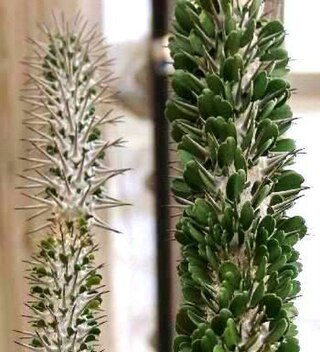
Ravenala is a genus of monocotyledonous flowering plants. Classically, the genus was considered to include a single species, Ravenala madagascariensis from Madagascar.

Didiereaceae is a family of flowering plants found in continental Africa and Madagascar. It contains 20 species classified in three subfamilies and six genera. Species of the family are succulent plants, growing in sub-arid to arid habitats. Several are known as ornamental plants in specialist succulent collections. The subfamily Didiereoideae is endemic to the southwest of Madagascar, where the species are characteristic elements of the spiny thickets.

Panicoideae is the second-largest subfamily of the grasses with over 3,500 species, mainly distributed in warm temperate and tropical regions. It comprises some important agricultural crops, including sugarcane, maize, sorghum, and switchgrass.
Hickelia is a genus of African bamboo in the grass family.
- Hickelia africanaS.Dransf. - Tanzania
- Hickelia alaotrensisA.Camus - Madagascar
- Hickelia madagascariensisA.Camus - Madagascar
- Hickelia perrieri(A.Camus) S.Dransf. - Madagascar
Perrierbambus is a genus of Madagascan bamboo in the grass family.

Brachyelytrum is a genus of North American and East Asian plants in the grass family, classified in its own tribe Brachyelytreae.

Echinolaena is a genus of plants in tribe Paspaleae of the grass family, native to the New World tropics. It includes only two species after the referral of former members to the related genera Hildaea, Ichnanthus, Oedochloa and the more distant Chasechloa in a 2015 revision.

Ampelodesmos is a genus of Mediterranean plants in the grass family, which is known by the common names stramma, Mauritania grass, rope grass, and dis(s) grass. It is classified in its own tribe Ampelodesmeae within the grass subfamily Pooideae.
Yvesia is a genus of plants in the grass family. The only known species is Yvesia madagascariensis, found only in Madagascar.

Puelia is a genus of African grasses, the only genus in the tribe Atractocarpeae. It belongs to the subfamily Puelioideae, one of the early-diverging lineages in the grasses, but used to be considered a bamboo genus.

Sartidia is a genus of Southern African and Madagascan plants in the grass family. It was split from Aristida in 1963 by South African botanist Bernard de Winter and contains six known species, of which Sartidia perrieri is considered extinct. Their natural habitats are warm, semi-arid savanna and dry forest at altitudes of 800–2,000 m (2,600–6,600 ft) where rainfall ranges from 250 to 1,500 mm per year. They are perennial grasses with inflorescence in a panicle.
Guaduella is a genus of African plants in the grass family, the only genus in the tribe Guaduelleae. It belongs to the subfamily Puelioideae, one of the early-diverging lineages in the grasses, but used to be included in the bamboos.
- Guaduella densifloraPilg. - Nigeria, Cabinda, Cameroon, Republic of Congo, Gabon, Equatorial Guinea
- Guaduella dichroaCope - Cabinda
- Guaduella humilisClayton - Nigeria, Cameroon
- Guaduella macrostachys(K.Schum.) Pilg. - Ghana, Nigeria, Cameroon, Gabon
- Guaduella marantifoliaFranch. - Cameroon, Republic of Congo, Gabon
- Guaduella oblongaHutch. ex Clayton - Guinea, Sierra Leone, Ivory Coast, Cameroon, Republic of Congo, Gabon, São Tomé, Bioko
Lecomtella is a genus of grasses with the sole species Lecomtella madagascariensis, native to Madagascar. It is the only genus in the tribe Lecomtelleae.

The flora of Madagascar consists of more than 12,000 species of plants, as well as a poorly known number of fungi and algae. Around 83% of Madagascar's vascular plants are found only on the island. These endemics include five plant families, 85% of the over 900 orchid species, around 200 species of palms, and such emblematic species as the traveller's tree, six species of baobab and the Madagascar periwinkle. The high degree of endemism is due to Madagascar's long isolation following its separation from the African and Indian landmasses in the Mesozoic, 150–160 and 84–91 million years ago, respectively. However, few plant lineages remain from the ancient Gondwanan flora; most extant plant groups immigrated via across-ocean dispersal well after continental break-up.
Oryza punctata is an annual grass in the rice genus Oryza, also known as red rice, related to cultivated rice O. sativa. O. punctata forms clumps or tussocks from 50–120 cm tall. It is a native to tropical Africa and Madagascar but is also found in Thailand and other parts of Indochina. O. punctata is a weed species in commercial rice growing operations although it appears to be rare in its native range. O. punctata has an IUCN status of least concern. It is not generally eaten or used as fodder by farmers but there is some evidence that it has been used as such during periods of famine. Due to the importance of the crop varieties of rice globally, the evolution of the Oryza genus as a whole has been studied extensively. A lot of information about O. punctata has been elucidated as a secondary benefit to this commercial research. O. punctata evolved some 5 million years ago in the second of two rapid radiation events that occurred in the Oryza L. genus.
Decaryella is a genus of plants in the grass family. The only known species is Decaryella madagascariensis, native to Madagascar.

Paspaleae is a tribe of the Panicoideae subfamily in the grasses (Poaceae), native mainly to the tropical and subtropical Americas but with a number of species introduced to other regions. It includes roughly 680 species in 39 genera. Species in this tribe use either of the C3 or C4 photosynthetic pathways.

Sartidia perrieri is a grass species endemic to Madagascar, known from only one collected individual and now considered extinct.

Aristida rufescens is a grass species native to Madagascar and to Mayotte in the Comoros archipelago. It was described by German agrostologist Ernst Gottlieb von Steudel in 1854.











